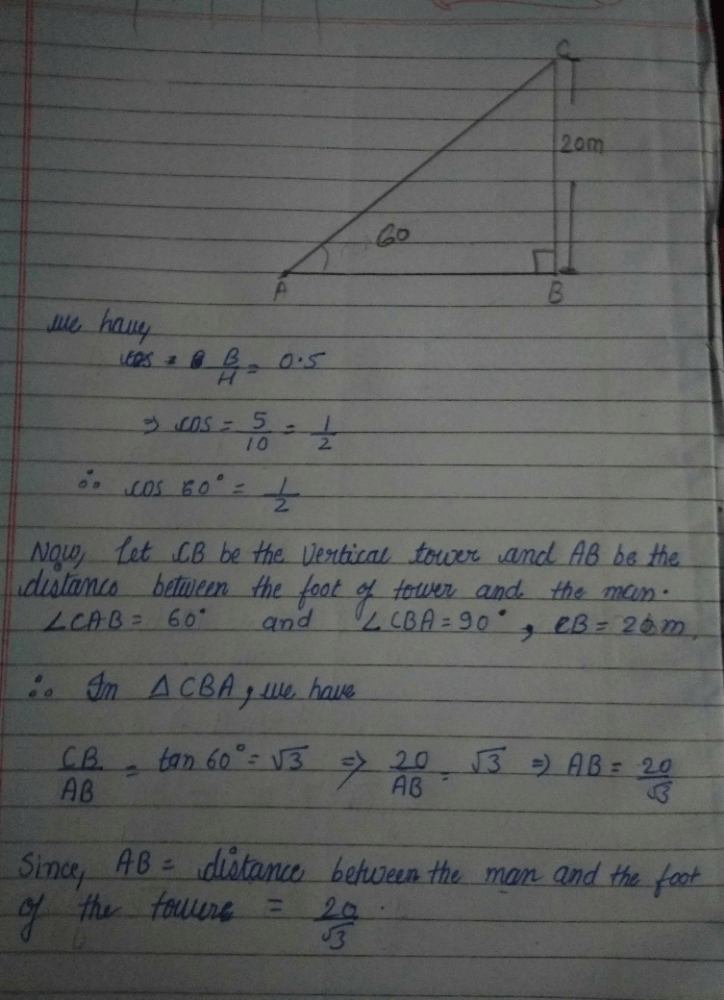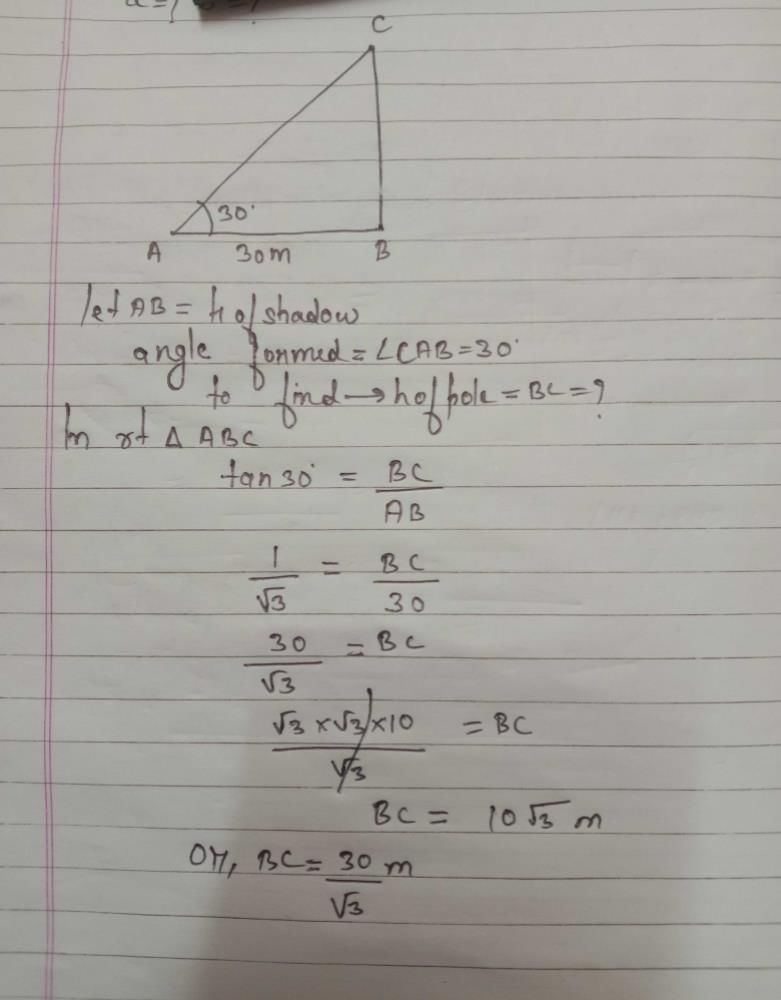All Exams >
Class 10 >
Weekly Tests for Class 10 Preparation >
All Questions
All questions of October Week 1 for Class 10 Exam
In Belgium, the percentage of French community is
- a)54%
- b)40%
- c)30%
- d)20%
Correct answer is option 'B'. Can you explain this answer?
In Belgium, the percentage of French community is
a)
54%
b)
40%
c)
30%
d)
20%
|
|
Vivek Rana answered |
In Belgium total population divided as:
- 40% of the population belongs to French Community.
- 59% of the population belongs to the Flemish Community.
- 1% to the German-speaking Community.
Which two languages are generally spoken in Belgium?- a)French and English
- b)Dutch and English
- c)French and Dutch
- d)Dutch and Sinhala
Correct answer is option 'C'. Can you explain this answer?
Which two languages are generally spoken in Belgium?
a)
French and English
b)
Dutch and English
c)
French and Dutch
d)
Dutch and Sinhala
|
|
Kiran Mehta answered |
The two languages are generally spoken in Belgium French and Dutch.
Dutch is the official language of the Flemish Community and the Flemish Region (merged to Flanders).
French, an official language of the Brussels-Capital Region.
Dutch is the official language of the Flemish Community and the Flemish Region (merged to Flanders).
French, an official language of the Brussels-Capital Region.
If the angle of elevation of a cloud from a point 60 metres above a lake is 30o and the angle of depression of its reflection in the lake is 60°, then the height of the cloud above the lake is
- a)30 m
- b)120 m
- c)200 m
- d)500 m
Correct answer is option 'B'. Can you explain this answer?
If the angle of elevation of a cloud from a point 60 metres above a lake is 30o and the angle of depression of its reflection in the lake is 60°, then the height of the cloud above the lake is
a)
30 m
b)
120 m
c)
200 m
d)
500 m
|
|
Neha Patel answered |
Let AB be the surface of the lake and P be the point of observation such that AP = 60 m. Let C be the position of the cloud and C be its reflection in the lake.
Then CB =
Draw PM⊥CB
Let CM = h
∴ CB = h + 60 m
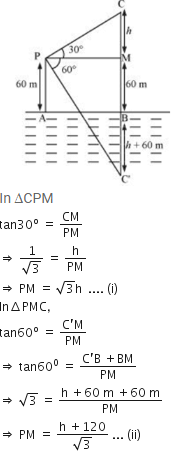
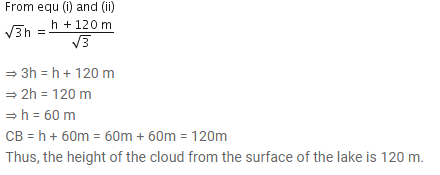
Belgium shares its border with- a)France
- b)Germany
- c)Luxembourg
- d)all the above
Correct answer is option 'D'. Can you explain this answer?
Belgium shares its border with
a)
France
b)
Germany
c)
Luxembourg
d)
all the above
|
|
Avinash Patel answered |
Belgium is a federal state located in Western Europe, bordering the North Sea.
Belgium shares borders with:
- France (556 km)
- Germany (133 km)
- Luxembourg (130 km)
- Netherlands (478 km)
Power struggle demanding separate Eelam was launched by:
- a)Sinhalese
- b)Buddhists
- c)Tamilians
- d)None of the above
Correct answer is option 'C'. Can you explain this answer?
Power struggle demanding separate Eelam was launched by:
a)
Sinhalese
b)
Buddhists
c)
Tamilians
d)
None of the above
|
|
Kiran Mehta answered |
Due to the policy of majoritarianism Tamilians were suppressed under the supremacy of sinhalese. So, they launched movements against this and demanded a separate Eelam.
A basket of vegetables contains carrot, potato, radish and tomato. Which of them represent the correct homologous structures?- a)Carrot and potato
- b)Carrot and tomato
- c)Radish and carrot
- d)Radish and potato
Correct answer is option 'C'. Can you explain this answer?
A basket of vegetables contains carrot, potato, radish and tomato. Which of them represent the correct homologous structures?
a)
Carrot and potato
b)
Carrot and tomato
c)
Radish and carrot
d)
Radish and potato

|
Sonika Attitdejaatni answered |
Homologous structures are those that are related by common ancestry. The common ancestry is reflected in a common structural plan. These structures might be adapted to suit different functional roles. Of the given options, potato is a storage stem, tomato is a fruit (in fact, it is a berry), radish and carrots are roots. Since both radish and carrots are roots, they have similar structural plans and are homologous.
So, the correct option is C
Match List-I (forms of power-sharing) with List-II (forms of government) and select the correct answer using the codes given below the lists :
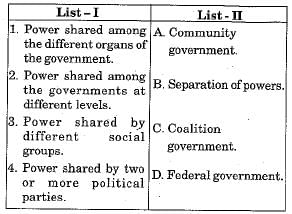
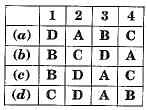
- a)a
- b)b
- c)c
- d)d
Correct answer is option 'C'. Can you explain this answer?
Match List-I (forms of power-sharing) with List-II (forms of government) and select the correct answer using the codes given below the lists :




a)
a
b)
b
c)
c
d)
d
|
|
Krishna Iyer answered |
(1) In a democracy, power is shared among different organs of government i.e. legislature, executive, and judiciary. This is known as the horizontal distribution of power because it allows different organs of government placed at the same level to exercise different powers.
(2) Federalism is the system of government in which power is divided between a central government and regional governments; in the United States, both the national government and the state governments possess a large measure of sovereignty.
(3) Power may also be shared among different social groups such as the religious and linguistic groups. ‘Community government’ in Belgium is a good example of this arrangement.
(4) Power shared by two or more political parties is the Coalition government.
Thus, option C is correct.
A man is standing on the deck of a ship, which is 8 m above water level. He observes the angle of elevation of the top of a hill as 60° and angle of depression of the base of the hill as 30°. What is the height of the hill?- a)

- b)24 m
- c)32 m
- d)

Correct answer is option 'C'. Can you explain this answer?
A man is standing on the deck of a ship, which is 8 m above water level. He observes the angle of elevation of the top of a hill as 60° and angle of depression of the base of the hill as 30°. What is the height of the hill?
a)
b)
24 m
c)
32 m
d)
|
|
Mubeena Akhter answered |
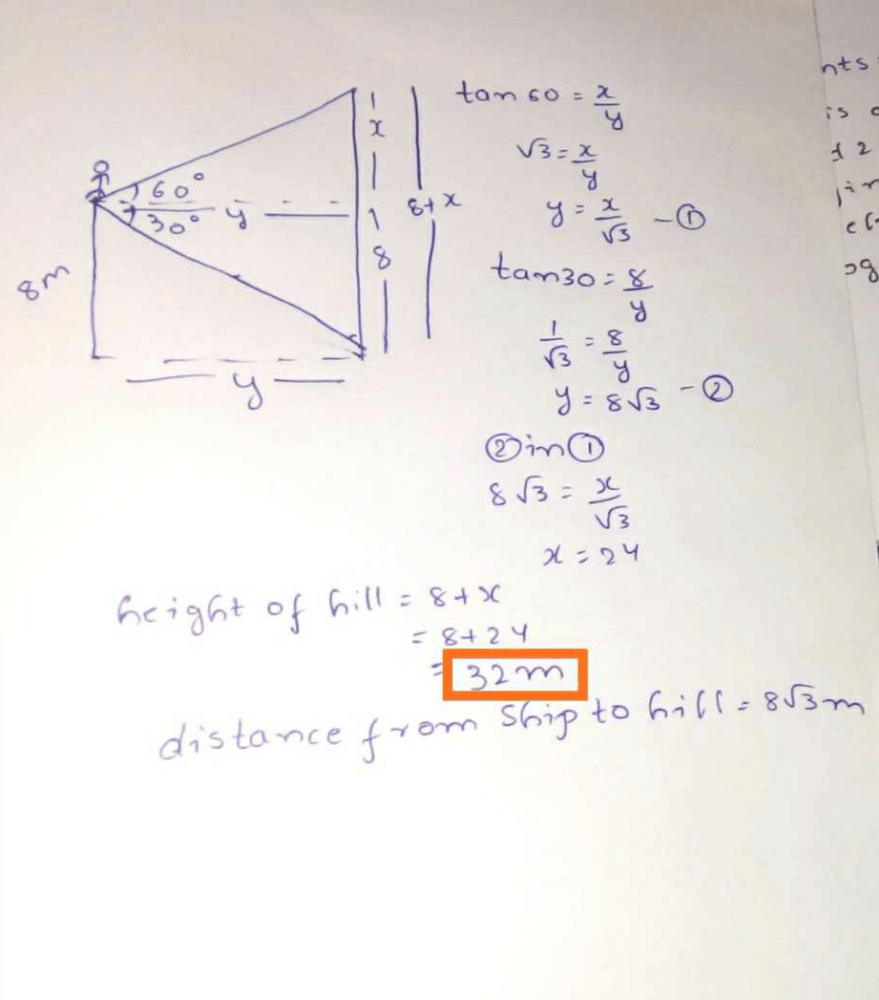
The traits which are expressed in first filial (F1) generation are known as which traits.- a)inherited
- b)dominant
- c)recessive
- d)acquired
Correct answer is option 'B'. Can you explain this answer?
The traits which are expressed in first filial (F1) generation are known as which traits.
a)
inherited
b)
dominant
c)
recessive
d)
acquired
|
|
Vivek Rana answered |
Blending Theory of Inheritance - offspring of two parents "blend" the traits of both parents
Particulate Theory of Inheritance - traits are inherited as "particles", offspring receive a "particle" from each parent.
Analysis:
- The F1 generation always displayed one trait (he later called this the dominant trait)
- The F1 generation must have within it the trait from the original parents - the white trait
- The F2 generation displayed the hidden trait, 1/4 of the F2 generation had it (he later called this hidden trait the recessive trait)
- Each individual has two "factors" that determine what external appearance the offspring will have. (We now call these factors genes or alleles)
An observer 1.5 m tall is 28.5 m away from a tower. The angle of elevation of the top of the tower from his eyes is 45°. The height of the tower is- a)10 m
- b)40 m
- c)30 m
- d)20 m
Correct answer is option 'C'. Can you explain this answer?
An observer 1.5 m tall is 28.5 m away from a tower. The angle of elevation of the top of the tower from his eyes is 45°. The height of the tower is
a)
10 m
b)
40 m
c)
30 m
d)
20 m
|
|
Swara sharma answered |
Understanding the Scenario
To solve the problem, we need to visualize the situation involving the observer and the tower. The observer is standing 28.5 m away from the base of the tower, and his height is 1.5 m. The angle of elevation to the top of the tower is 45 degrees.
Key Concepts
- Angle of Elevation: It is the angle formed by the line of sight of an observer looking up at an object.
- Right Triangle: The observer, the tower, and the ground form a right triangle where:
- The height of the tower is the opposite side.
- The distance from the observer to the tower is the adjacent side.
Calculating the Height of the Tower
1. Right Triangle Properties:
- The height from the observer's eyes to the top of the tower can be calculated using the tangent function since the angle of elevation is 45 degrees.
- For an angle of 45 degrees, the tangent of the angle is equal to 1 (tan(45) = 1).
2. Using the Distance:
- The distance from the observer to the tower is 28.5 m. Therefore, we have:
- Height from observer's eyes to tower top = tan(45 degrees) * distance
- This gives us: Height = 1 * 28.5 m = 28.5 m.
3. Total Height of the Tower:
- Since the observer's height is 1.5 m, the total height of the tower is:
- Total Height = Height from eyes to tower top + Height of observer
- Total Height = 28.5 m + 1.5 m = 30 m.
Conclusion
Thus, the height of the tower is 30 m, which corresponds to option C.
To solve the problem, we need to visualize the situation involving the observer and the tower. The observer is standing 28.5 m away from the base of the tower, and his height is 1.5 m. The angle of elevation to the top of the tower is 45 degrees.
Key Concepts
- Angle of Elevation: It is the angle formed by the line of sight of an observer looking up at an object.
- Right Triangle: The observer, the tower, and the ground form a right triangle where:
- The height of the tower is the opposite side.
- The distance from the observer to the tower is the adjacent side.
Calculating the Height of the Tower
1. Right Triangle Properties:
- The height from the observer's eyes to the top of the tower can be calculated using the tangent function since the angle of elevation is 45 degrees.
- For an angle of 45 degrees, the tangent of the angle is equal to 1 (tan(45) = 1).
2. Using the Distance:
- The distance from the observer to the tower is 28.5 m. Therefore, we have:
- Height from observer's eyes to tower top = tan(45 degrees) * distance
- This gives us: Height = 1 * 28.5 m = 28.5 m.
3. Total Height of the Tower:
- Since the observer's height is 1.5 m, the total height of the tower is:
- Total Height = Height from eyes to tower top + Height of observer
- Total Height = 28.5 m + 1.5 m = 30 m.
Conclusion
Thus, the height of the tower is 30 m, which corresponds to option C.
The normal number of chromosomes in the progeny is maintained when the germ cells:- a)take all maternal and paternal chromosomes
- b)divide by the process of mitosis
- c)divide by mitosis and take all maternal and paternal chromosome
- d)take one chromosome from each pair
Correct answer is option 'D'. Can you explain this answer?
The normal number of chromosomes in the progeny is maintained when the germ cells:
a)
take all maternal and paternal chromosomes
b)
divide by the process of mitosis
c)
divide by mitosis and take all maternal and paternal chromosome
d)
take one chromosome from each pair
|
|
Rahul Kapoor answered |
The number of chromosomes in each generation are maintained due to meiosis. The meiosis is a kind of reductive division. When gametes are formed by meiosis, the number of chromosomes are halved. Hence each gamete will have only one pair of chromosome.
Later the haploid gamete will fuse with the complementary haploid gamete and form Diploid Zygote(2n). Hence the number of chromosomes are maintained.
For more details you can view my old answers regarding S-phase, certain stages of meiosis etc. If still you have doubts, you can ask anytime or you can refer Molecular cell biology by Bruce Alberts.
The horizontal distance between two towers is 140 m. The angle of elevation of the top of the first tower when seen from the top of the second tower is 30o. If the height of the second tower is 60 m then, the height of the first tower is- a)140.83 m
- b)135 m
- c)139.5 m
- d)142 m
Correct answer is option 'A'. Can you explain this answer?
The horizontal distance between two towers is 140 m. The angle of elevation of the top of the first tower when seen from the top of the second tower is 30o. If the height of the second tower is 60 m then, the height of the first tower is
a)
140.83 m
b)
135 m
c)
139.5 m
d)
142 m
|
|
Amit Sharma answered |
The second tower is smaller than the first tower so let the height of the first tower is h So a part of it is equal to 60m so the remaining height is h-60 m
Tan 30=perpendicular/base


Tan 30=perpendicular/base


A tree is broken by wind and its upper part touches the ground at a point 10 metres from the foot of the tree and makes an angle of 45° with the ground. The entire length of the tree is- a)20 m
- b)10(1+√2)m
- c)10 m
- d)10√2 m
Correct answer is option 'B'. Can you explain this answer?
A tree is broken by wind and its upper part touches the ground at a point 10 metres from the foot of the tree and makes an angle of 45° with the ground. The entire length of the tree is
a)
20 m
b)
10(1+√2)m
c)
10 m
d)
10√2 m
|
|
Drishti Kumari answered |
Base = 10m
Angle of elevation = 45 degree
tan 45 ^ = P / b ( Let p supoose h )
1= h / 10
h = 10 m
height of half tree = 10 m
Now the length of broken part i.e, hypotenuse
H^2 = P ^2 + B ^2
H ^2 = 10^2 + 10 ^2
H ^2 = 100 +100
H = root under 100
H = 10 root 2
Hence , the length of entire tree = 10 + 10 root2
10 ( 1 + root 2 )
That's why B is the correct optipn .
Angle of elevation = 45 degree
tan 45 ^ = P / b ( Let p supoose h )
1= h / 10
h = 10 m
height of half tree = 10 m
Now the length of broken part i.e, hypotenuse
H^2 = P ^2 + B ^2
H ^2 = 10^2 + 10 ^2
H ^2 = 100 +100
H = root under 100
H = 10 root 2
Hence , the length of entire tree = 10 + 10 root2
10 ( 1 + root 2 )
That's why B is the correct optipn .
Who are the minority community in Belgium?
- a)English Speaking
- b)French Speaking
- c)Dutch Speaking
- d)None
Correct answer is option 'B'. Can you explain this answer?
Who are the minority community in Belgium?
a)
English Speaking
b)
French Speaking
c)
Dutch Speaking
d)
None
|
|
Dheeraj kumar answered |
The Minority Community in Belgium: French Speaking
Belgium is a country that is divided into two main linguistic communities: the Dutch-speaking Flemish community and the French-speaking Walloon community. There is also a small German-speaking community. The French-speaking community is considered a minority community in Belgium, and this is the correct answer to the question.
Reasons for the Minority Status
There are historical and political reasons for the minority status of the French-speaking community in Belgium. Belgium was originally a Dutch-speaking country, but after the Belgian Revolution in 1830, the French-speaking community gained more power and influence. This led to tensions between the Dutch-speaking and French-speaking communities, which were exacerbated by political and economic differences.
The linguistic divide in Belgium has also led to a lack of integration and communication between the two communities. This has resulted in the French-speaking community being marginalized and considered a minority community within Belgium.
Impact on Society
The minority status of the French-speaking community in Belgium has had an impact on society in various ways. For example:
- Political representation: The French-speaking community has less political representation than the Dutch-speaking community, which has led to a lack of voice and influence in government decisions.
- Education: The French-speaking community has its own education system, which is separate from the Dutch-speaking community. This has led to a lack of integration between the two communities and has perpetuated the linguistic divide.
- Economic opportunities: The linguistic divide has also led to a lack of economic opportunities for the French-speaking community, particularly in the Dutch-speaking regions of Belgium.
Conclusion
In conclusion, the minority community in Belgium is the French-speaking community. This is due to historical, political, and linguistic reasons, which have led to a lack of integration, representation, and opportunities for this community.
Belgium is a country that is divided into two main linguistic communities: the Dutch-speaking Flemish community and the French-speaking Walloon community. There is also a small German-speaking community. The French-speaking community is considered a minority community in Belgium, and this is the correct answer to the question.
Reasons for the Minority Status
There are historical and political reasons for the minority status of the French-speaking community in Belgium. Belgium was originally a Dutch-speaking country, but after the Belgian Revolution in 1830, the French-speaking community gained more power and influence. This led to tensions between the Dutch-speaking and French-speaking communities, which were exacerbated by political and economic differences.
The linguistic divide in Belgium has also led to a lack of integration and communication between the two communities. This has resulted in the French-speaking community being marginalized and considered a minority community within Belgium.
Impact on Society
The minority status of the French-speaking community in Belgium has had an impact on society in various ways. For example:
- Political representation: The French-speaking community has less political representation than the Dutch-speaking community, which has led to a lack of voice and influence in government decisions.
- Education: The French-speaking community has its own education system, which is separate from the Dutch-speaking community. This has led to a lack of integration between the two communities and has perpetuated the linguistic divide.
- Economic opportunities: The linguistic divide has also led to a lack of economic opportunities for the French-speaking community, particularly in the Dutch-speaking regions of Belgium.
Conclusion
In conclusion, the minority community in Belgium is the French-speaking community. This is due to historical, political, and linguistic reasons, which have led to a lack of integration, representation, and opportunities for this community.
A zygote which has an X-chromosome inherited from the father will develop into a- a)Boy
- b)Girl
- c) X-chromosome does not determine the sex of a child
- d)Either boy or girl
Correct answer is option 'B'. Can you explain this answer?
A zygote which has an X-chromosome inherited from the father will develop into a
a)
Boy
b)
Girl
c)
X-chromosome does not determine the sex of a child
d)
Either boy or girl

|
Sushant Sen answered |
Explanation: Humans follow XX- XY mechanism of sex determination.
A pea plant shows the genetic makeup TtRr. How will the plant appear externally?- a)Tall with wrinkled seeds
- b)Dwarf with round seeds
- c)Dwarf with wrinkled seeds
- d)Tall with round seeds
Correct answer is option 'D'. Can you explain this answer?
A pea plant shows the genetic makeup TtRr. How will the plant appear externally?
a)
Tall with wrinkled seeds
b)
Dwarf with round seeds
c)
Dwarf with wrinkled seeds
d)
Tall with round seeds

|
The Eliminator answered |
Correct answer is:- (d) tall with round seeds
explanation:- since T and R are dominant traits and t and r are ressassive traits. So tall and round are dominant that's why they hide the identity of dwarf and wrinkled so that the seeds looks tall and round.
explanation:- since T and R are dominant traits and t and r are ressassive traits. So tall and round are dominant that's why they hide the identity of dwarf and wrinkled so that the seeds looks tall and round.
A man is standing on the deck of a ship, which is 8 m above water level. He observes the angle of elevation of the top of a hill as 60° and angle of depression of the base of the hill as 30°. What is the height of the hill?- a)24√3 m
- b)24 m
- c)8√3 m
- d)32 m
Correct answer is option 'D'. Can you explain this answer?
A man is standing on the deck of a ship, which is 8 m above water level. He observes the angle of elevation of the top of a hill as 60° and angle of depression of the base of the hill as 30°. What is the height of the hill?
a)
24√3 m
b)
24 m
c)
8√3 m
d)
32 m
|
|
Mysterio Man answered |
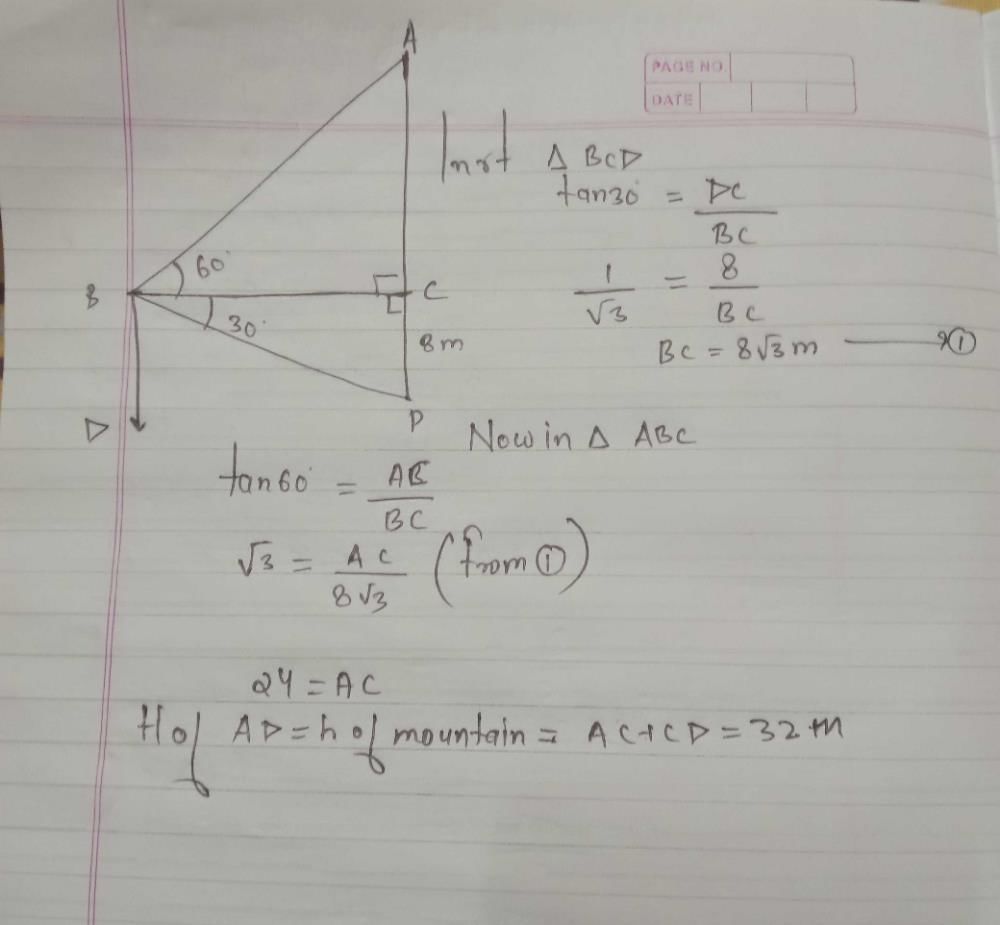
If the angles of depression from the top of a tower of height 40 m to the top and bottom of a tree are 45° and 60° respectively, then the height of the tree is- a)

- b)

- c)

- d)None of the above
Correct answer is option 'B'. Can you explain this answer?
If the angles of depression from the top of a tower of height 40 m to the top and bottom of a tree are 45° and 60° respectively, then the height of the tree is
a)
b)
c)
d)
None of the above

|
EduRev Class 10 answered |
A tower of height 40 m is given, and the angles of depression from the top of the tower to:
- The top of the tree = 45°
- The bottom of the tree = 60°
We need to find the height of the tree (h).
Step 1: Use trigonometry for the angles of depression
Let:
Let:
- The distance between the base of the tower and the base of the tree = d
- The height of the tree = h
From the 45° angle (to the top of the tree):
The formula is:
tan(45°) = (Height of the tower - Height of the tree) / Distance (d)
Since tan(45°) = 1:
1 = (40 - h) / d
d = 40 - h (1)
From the 60° angle (to the bottom of the tree):
The formula is:
tan(60°) = Height of the tower / Distance (d)
Since tan(60°) = √3:
√3 = 40 / d
d = 40 / √3 (2)
Step 2: Solve the equations
Equate d from equations (1) and (2):
40 - h = 40 / √3
Rearrange to solve for h:
h = 40 - (40 / √3)
Rationalize the denominator:
h = 40 - (40√3 / 3)
h = (120 / 3) - (40√3 / 3)
h = (40 (3 - √3)) / 3
The height of the tree is:
b) (40 / 3) (3 - √3)
A trait in an organism is influenced by- a) Paternal DNA only
- b) Maternal DNA only
- c)Both maternal and paternal DNA
- d)Neither by paternal nor by maternal DNA
Correct answer is option 'C'. Can you explain this answer?
A trait in an organism is influenced by
a)
Paternal DNA only
b)
Maternal DNA only
c)
Both maternal and paternal DNA
d)
Neither by paternal nor by maternal DNA

|
Anisha Mukherjee answered |
Explanation: An organism develops from zygote which in turn is product of fusion of male and female gamete.
Which of the following act as an information source for making proteins in a cell?- a)DNA
- b)Lipids
- c)RNA
- d)Carbohydrates
Correct answer is option 'A'. Can you explain this answer?
Which of the following act as an information source for making proteins in a cell?
a)
DNA
b)
Lipids
c)
RNA
d)
Carbohydrates
|
|
Vivek Rana answered |
The DNA in the nucleus of a cell is the information source for making proteins. If the information is changed, different proteins will be made. The basic event in reproduction is the creation of a DNA copy. Cells use chemical reactions to build copies of their DNA. This creates two copies of the DNA in a reproducing cell and they need to get separated from each other. DNA copying is accompanied by the creation of an additional cellular apparatus, and then the DNA copies separate, each with its own cellular apparatus.
Exchange of genetic material takes place in- a)Vegetative reproduction
- b)Asexual reproduction
- c)Sexual reproduction
- d)Budding
Correct answer is option 'C'. Can you explain this answer?
Exchange of genetic material takes place in
a)
Vegetative reproduction
b)
Asexual reproduction
c)
Sexual reproduction
d)
Budding

|
Sushant Sen answered |
Explanation: Sexual reproduction involves meiosis in gamete mother cells to form gametes and fusion of male and female gametes into zygote.
In Belgium, how is power distributed in the government of Brussels?- a)Unequal representation based on linguistic groups
- b)Equal representation of Dutch-speaking ministers only
- c)Equal representation of French-speaking ministers only
- d)Equal representation of both linguistic groups
Correct answer is option 'D'. Can you explain this answer?
In Belgium, how is power distributed in the government of Brussels?
a)
Unequal representation based on linguistic groups
b)
Equal representation of Dutch-speaking ministers only
c)
Equal representation of French-speaking ministers only
d)
Equal representation of both linguistic groups

|
EduRev Class 10 answered |
In the government of Brussels, power is distributed in a manner that ensures equal representation of both linguistic groups, namely the Dutch-speaking and French-speaking communities. This approach aims to promote inclusivity and fairness in governance, reflecting the diverse linguistic and cultural landscape of the capital city.
What characterizes a Coalition Government in governance?- a)Single-party domination
- b)Limited legislative powers
- c)Collaboration between multiple parties
- d)Authoritarian rule
Correct answer is option 'C'. Can you explain this answer?
What characterizes a Coalition Government in governance?
a)
Single-party domination
b)
Limited legislative powers
c)
Collaboration between multiple parties
d)
Authoritarian rule
|
|
Kavya nambiar answered |
Understanding Coalition Government
A coalition government is formed when multiple political parties come together to create a governing body. This arrangement typically occurs in systems where no single party gains an outright majority in the legislature.
Key Characteristics of Coalition Government
- Collaboration Between Multiple Parties
- In a coalition government, parties negotiate and collaborate to form a stable government. This often involves compromises on policies and sharing power to ensure effective governance.
- Diverse Representation
- Coalition governments represent a wider range of political views and interests, reflecting the diverse electorate. This can lead to more comprehensive policy-making that considers various perspectives.
- Stability Through Cooperation
- By working together, parties in a coalition can achieve greater stability than they might on their own. Joint efforts help to manage conflicts and foster a sense of shared responsibility.
- Legislative Challenges
- While collaboration can lead to effective governance, it may also result in challenges, such as slower decision-making processes due to differing agendas and the need for consensus.
Conclusion
In summary, a coalition government is characterized by collaboration between multiple parties, allowing for broader representation and potentially more stable governance. This contrasts with single-party domination, limited legislative powers, or authoritarian rule, which do not involve the same level of cooperative engagement among diverse political entities.
A coalition government is formed when multiple political parties come together to create a governing body. This arrangement typically occurs in systems where no single party gains an outright majority in the legislature.
Key Characteristics of Coalition Government
- Collaboration Between Multiple Parties
- In a coalition government, parties negotiate and collaborate to form a stable government. This often involves compromises on policies and sharing power to ensure effective governance.
- Diverse Representation
- Coalition governments represent a wider range of political views and interests, reflecting the diverse electorate. This can lead to more comprehensive policy-making that considers various perspectives.
- Stability Through Cooperation
- By working together, parties in a coalition can achieve greater stability than they might on their own. Joint efforts help to manage conflicts and foster a sense of shared responsibility.
- Legislative Challenges
- While collaboration can lead to effective governance, it may also result in challenges, such as slower decision-making processes due to differing agendas and the need for consensus.
Conclusion
In summary, a coalition government is characterized by collaboration between multiple parties, allowing for broader representation and potentially more stable governance. This contrasts with single-party domination, limited legislative powers, or authoritarian rule, which do not involve the same level of cooperative engagement among diverse political entities.
In power-sharing between different political groups, what role does the representation of various political groups play in a democratic system?- a)Exclusion of certain political ideologies
- b)Promotion of one-party rule
- c)Encouragement of political diversity
- d)Elimination of political competition
Correct answer is option 'C'. Can you explain this answer?
In power-sharing between different political groups, what role does the representation of various political groups play in a democratic system?
a)
Exclusion of certain political ideologies
b)
Promotion of one-party rule
c)
Encouragement of political diversity
d)
Elimination of political competition

|
Kamna Science Academy answered |
In power-sharing between different political groups, the representation of various political groups plays a crucial role in a democratic system by encouraging political diversity. This diversity fosters healthy debate, ensures the consideration of multiple viewpoints, and promotes checks and balances within the political landscape. It also reflects the pluralistic nature of democracy, where different ideologies and interests coexist and contribute to the decision-making process.
Power-sharing between different levels of government, what does the term "federalism" refer to?
- a)Power concentration in the central government only
- b)Distribution of power among various levels of government
- c)Power concentration in local governments only
- d)Absence of any governmental structure
Correct answer is option 'B'. Can you explain this answer?
Power-sharing between different levels of government, what does the term "federalism" refer to?
a)
Power concentration in the central government only
b)
Distribution of power among various levels of government
c)
Power concentration in local governments only
d)
Absence of any governmental structure
|
|
Jay Dasgupta answered |
Federalism refers to the distribution of power among various levels of government. It is a system of government in which power is divided between a central authority and constituent political units, such as states or provinces. This system allows for power-sharing and cooperation between different levels of government while also preserving some degree of autonomy for the subnational units.
Key Points:
- Division of Power: Federalism involves the sharing of power between the central government and regional governments. This division of power helps prevent the concentration of authority in one single entity.
- Autonomy: Regional governments under a federal system typically have some degree of autonomy to govern their respective territories. This allows for tailored policies and decision-making that are more responsive to local needs.
- Cooperation: Federalism promotes cooperation and coordination between different levels of government. While each level has its own areas of authority, they must also work together on issues that affect the entire country.
- Balance of Power: Federalism helps maintain a balance of power between the central government and regional governments. This balance is crucial for ensuring that no level of government becomes too dominant or overreaching.
In conclusion, federalism refers to the distribution of power among various levels of government, allowing for a balanced system of governance that promotes cooperation, autonomy, and the sharing of responsibilities.
Key Points:
- Division of Power: Federalism involves the sharing of power between the central government and regional governments. This division of power helps prevent the concentration of authority in one single entity.
- Autonomy: Regional governments under a federal system typically have some degree of autonomy to govern their respective territories. This allows for tailored policies and decision-making that are more responsive to local needs.
- Cooperation: Federalism promotes cooperation and coordination between different levels of government. While each level has its own areas of authority, they must also work together on issues that affect the entire country.
- Balance of Power: Federalism helps maintain a balance of power between the central government and regional governments. This balance is crucial for ensuring that no level of government becomes too dominant or overreaching.
In conclusion, federalism refers to the distribution of power among various levels of government, allowing for a balanced system of governance that promotes cooperation, autonomy, and the sharing of responsibilities.
What is the significance of political parties forming an alliance and participating in direct power-sharing in a coalition government?- a)It leads to a decrease in the influence of political groups
- b)It enhances transparency and accountability in governance
- c)It often results in the exclusion of minority groups from decision-making
- d)It can lead to more stable governance through cooperation and consensus-building
Correct answer is option 'D'. Can you explain this answer?
What is the significance of political parties forming an alliance and participating in direct power-sharing in a coalition government?
a)
It leads to a decrease in the influence of political groups
b)
It enhances transparency and accountability in governance
c)
It often results in the exclusion of minority groups from decision-making
d)
It can lead to more stable governance through cooperation and consensus-building

|
Nk Classes answered |
When political parties form an alliance and engage in direct power-sharing through a coalition government, it can contribute to more stable governance within a democratic framework. By fostering cooperation and consensus-building among different political factions, coalition governments have the potential to promote inclusivity, compromise, and broader representation in decision-making processes. This collaborative approach to governance can help address diverse interests and perspectives, leading to more effective policymaking and administration.
Grain colour in wheat is determined by three pairs of polygene. Following the cross AABBCC (dark colour) x aabbcc (light colour), in F2-generation what proportion of the progeny is likely to resemble either parent- a)One fourth
- b)Less than 5 percent
- c)One third
- d)None of these
Correct answer is option 'B'. Can you explain this answer?
Grain colour in wheat is determined by three pairs of polygene. Following the cross AABBCC (dark colour) x aabbcc (light colour), in F2-generation what proportion of the progeny is likely to resemble either parent
a)
One fourth
b)
Less than 5 percent
c)
One third
d)
None of these
|
|
Learnever Education answered |
Polygene results in quantitative inheritance which is characterized by occurrence of intermediate forms between the parental type. In case of crossing between AABBCC (dark colour) and aabbcc (light colour), in F2 generation seven phenotypes will obtain with ratio of 1 : 6 : 15 : 20 : 15 : 6 : 1. The total number of progeny is 64, out of which only two will be likely resemble with either parents. Hence, their proportion in F2 generation would be 3.12 ie, less than 5%.
चित्तियों वाले केलों की क्या विशेषता होती हैं?- a)वे सुपाच्य होते हैं
- b)वे सस्ते होते हैं
- c)वे अधिक दिन तक नहीं रह सकते
- d)वे गर्मियों में ही मिलते हैं
Correct answer is option 'A'. Can you explain this answer?
चित्तियों वाले केलों की क्या विशेषता होती हैं?
a)
वे सुपाच्य होते हैं
b)
वे सस्ते होते हैं
c)
वे अधिक दिन तक नहीं रह सकते
d)
वे गर्मियों में ही मिलते हैं
|
|
Nilanjan Unni answered |
This question is incomplete as it does not provide any context or information to make a proper answer choice. Without any additional information, it is not possible to determine the correct answer for this question.
It is important to provide sufficient details or a complete question in order to accurately answer it. Please provide more information or context so that I can assist you better.
It is important to provide sufficient details or a complete question in order to accurately answer it. Please provide more information or context so that I can assist you better.
What is the phenotypic ratio observed in the F2 generation after self-fertilization in the given diagram?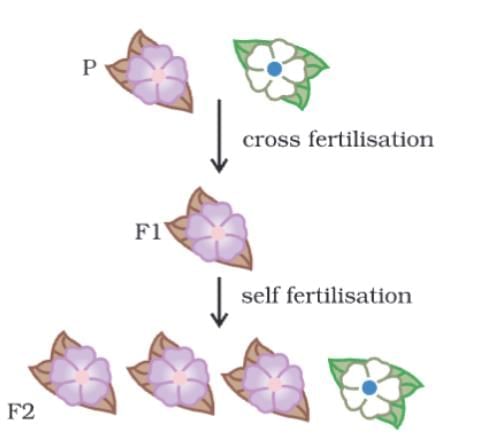
- a)1:1
- b)2:1
- c)3:1
- d)4:1
Correct answer is option 'C'. Can you explain this answer?
What is the phenotypic ratio observed in the F2 generation after self-fertilization in the given diagram?

a)
1:1
b)
2:1
c)
3:1
d)
4:1

|
Kds Coaching answered |
F2 Generation (Second Filial Generation):
The result shows a phenotypic ratio of 3:1:
3 purple-flowered plants (dominant phenotype)
1 white-flowered plant (recessive phenotype)
This 3:1 ratio is the classic Mendelian phenotypic ratio for a monohybrid cross.
Chapter doubts & questions for October Week 1 - Weekly Tests for Class 10 Preparation 2025 is part of Class 10 exam preparation. The chapters have been prepared according to the Class 10 exam syllabus. The Chapter doubts & questions, notes, tests & MCQs are made for Class 10 2025 Exam. Find important definitions, questions, notes, meanings, examples, exercises, MCQs and online tests here.
Chapter doubts & questions of October Week 1 - Weekly Tests for Class 10 Preparation in English & Hindi are available as part of Class 10 exam.
Download more important topics, notes, lectures and mock test series for Class 10 Exam by signing up for free.

Contact Support
Our team is online on weekdays between 10 AM - 7 PM
Typical reply within 3 hours
|
Free Exam Preparation
at your Fingertips!
Access Free Study Material - Test Series, Structured Courses, Free Videos & Study Notes and Prepare for Your Exam With Ease

 Join the 10M+ students on EduRev
Join the 10M+ students on EduRev
|

|
Create your account for free
OR
Forgot Password
OR
Signup on EduRev and stay on top of your study goals
10M+ students crushing their study goals daily


